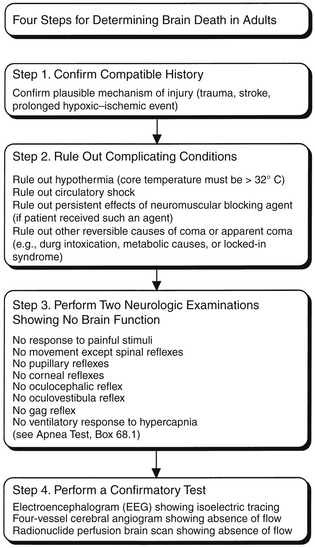Chapter 68
Brain Death and Management of Potential Organ Donors
This chapter discusses those accepted medical standards and how to test for them.
Making a timely and accurate diagnosis of brain death is an essential skill of intensivists. It is important for several reasons: (1) caring for the family’s needs, (2) allocating limited intensive care unit (ICU) resources fairly and wisely, and (3) providing opportunities for organ donation. In general, it requires a review of the patient’s medical history, two neurologic examinations, and, in some circumstances, the use of a confirmatory diagnostic test (Figure 68.1).
Determination of Brain Death
Medical History
The initial evaluation of the potentially brain dead patient should focus on the patient’s history (see Figure 68.1). There should be an identifiable and reasonable cause to explain the patient’s current condition. Next, the clinician must exclude reversible causes of coma, such as toxic or metabolic causes. Any such confounding condition must be corrected before continuing the evaluation. These include gross physiologic disturbances, such as hypothermia, hypoxemia, and hypotension or circulatory shock; metabolic derangements, such as acidosis, hypo- or hyperglycemia, and renal or hepatic encephalopathy; and serious electrolyte disorders, such as hypo- or hypernatremia and hypo- or hypercalcemia.
Drug overdose or toxic exposure should always be ruled out in patients presenting to the ICU in coma and who otherwise appear brain dead. In most cases, if a patient has received sedatives or analgesics before the evaluation for brain death, adequate time (usually four times the excretion half-life of the substance, taking into account hepatic or renal dysfunction when present) for elimination of the substance must occur.
Particular attention must be given to patients in whom neuromuscular blocking agents were used to ensure they have been adequately cleared from the circulation (see Chapter 5). A peripheral nerve stimulator should be used in all patients undergoing evaluation for brain death who received neuromuscular blocking agents.
Physical Examination in Brain Death Determination
Coma
For the purpose of brain death determination, coma is defined as the absence of observable responses to noxious stimuli, other than those produced by spinal cord reflexes. Coma manifests as lack of cerebral motor activity in response to pain in all four extremities and the head. Stimuli of sufficient intensity should be used such as strong pressure to the nailbeds and the supraorbital ridges. Grimacing, moaning, or nonstereotyped movements are inconsistent with brain death.
Absence of Brain Stem Reflexes
The apnea test is used to confirm brain death clinically only when the aforementioned preconditions have been met and when all other brain stem reflexes are absent. Because it requires an intact phrenic nerve and functioning diaphragm, it should not be performed if patients have a high cervical fracture or neuromuscular disease impairing diaphragmatic function. Maintaining adequate oxygenation during the test and documenting a rise in Paco2 to a level that would stimulate respiration in an intact patient is critical to performing a successful apnea test (Box 68.1).

Full access? Get Clinical Tree






